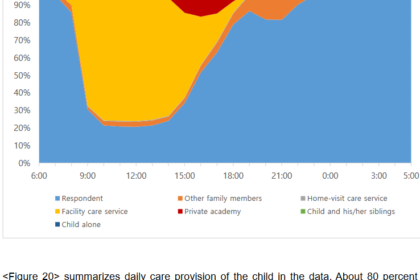
The rise of the care crisis in South Korea has evolved with Korea’s demographic shifts, increasing female work force participation, and changes in the norms and values of family and care over previous decades. Childcare and eldercare, once regarded as women’s typical role within family, are now gaining more social recognition in the public realm. Kang and Eun (2019) examine the nature of, and demand for, caregiving in various areas of the South Korean economy, including family care, care services, childcare and eldercare. The study is based on the nationally representative Care Work Family Surveys on Childcare and Eldercare.
The authors find a significant gap between the number of hours spent on childcare by mothers and fathers. A majority of respondents (women) used at least one external care service. Among caregiving activities, housework such as preparing meals, cleaning, and laundry were reported as the most difficult as well as the most frequently performed activities. Relational and physical activities such as helping to dress, wash, or play with children were reported as less difficult. Caregiving for the elderly can be more complex compared to care arrangements for children, because the range of participants in the family varies. Among all respondents, daughters-in-law were the primary caregiver in the greatest number of cases, followed by daughters, spouses, and sons. Spouses spent the highest number of hours on caregiving, followed by daughter in laws. External care services were not as common for elderly care. Home visit care and home bathing services from the National Long-Term Care program were the most commonly utilized services, although the 3-hour limit per visit amounts to a low amount of total caregiving time. Assisting with bathing and using the restroom was considered especially difficult for the elderly. Housework was performed with the same intensity and frequency in both childcare and eldercare, highlighting the important role it plays in both.
This paper will be available December 2019
This blog was authored by Eunhye Kang and Ki-Soo Eun
